120 kW of reserve energy or How to power the estate from the energy of the sun
Recently, I talked about a solar power station capable of providing energy to a production workshop . This time I will talk about an even more powerful and interesting solar power plant: suffice it to say that the peak output power is 120 kW, and in a month it produces up to 9 MWh!
To begin with, I will tell you a little about the history of the creation of this SES. Geographically, the facility is located in the Krasnodar Territory, where nature itself has the opportunity to use the energy of the sun. In addition, in the Krasnodar Territory there is a problem with the power supply in the summer months: because of the heat, everyone is beginning to actively use air conditioners and refrigeration units, thereby increasing the load on the electrical network. And the power plants themselves are also in harsh conditions: increased load, plus high temperatures, and this is where accidents and temporary outages occur.
So, the owner decided to protect his house and homestead from such power outages. The task was to provide autonomous power supply for a period of up to 3 hours. Practice has shown that the energy sector, as a rule, has had time to carry out all the work and restore the supply voltage.
')
Thus, it was decided to install autonomous inverters with batteries. The calculation was made on the full reservation of the entire estate in full for a period of 3 hours. Since this period could be longer, it was decided to add a diesel generator to the autonomous inverters.

It is logical that after installing autonomous inverters, the next step was the addition of solar panels. Thus, it was possible, without regard to the absence of an external network, to use electricity. Probably, the time has come for technical information.
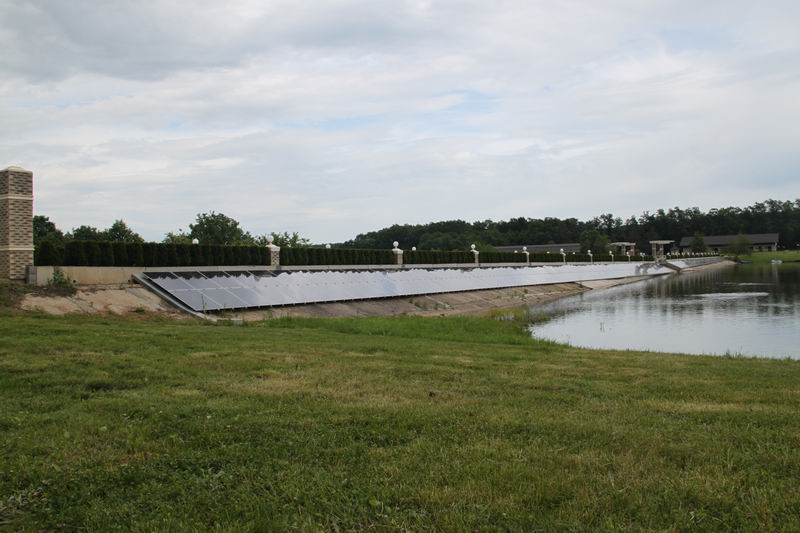
Solar modules: Micromorphic, Pramac (Switzerland) 125W x 360pcs.
Installed power of solar modules: 45kW
Solar controllers: IES DOMINATOR MPPT 200/100 200V 100A x 9pcs.
Inverters: MAP DOMINATOR 20kW x 6pcs (3-phase system of 2 MAP per phase)
Total inverter power: 120kW
Batteries: Crusade assembly 8PzS960 960Ach 48V with hydrogen recombination plugs x 6pcs
Total battery capacity: 5760Ah, 276kW * h
Diesel generator: JCB G115QS 90kW with automatic control.
Micromorphic solar cells have one feature: their efficiency is slightly more than 9%, but at the same time they capture the infrared part of the spectrum, which means they are capable of producing more energy at sunrise, sunset and during cloudiness. In addition, each solar battery provides up to 100V voltage and has a capacity of 125 watts. Due to this, the fault tolerance problem was solved: all panels are connected in parallel and divided into 18 segments. Accordingly, in each segment turned out 20 panels, giving 2.5 kW of power. Since the panels are arranged in two rows, the results were decent along the length of the line. Here SIP wire came in handy, which has a sufficient cross section at an affordable price. and if one panel fails, the other 19 continue to work. And if the line is interrupted, only one of the 20 segments will fall out of work, so the losses will be insignificant.
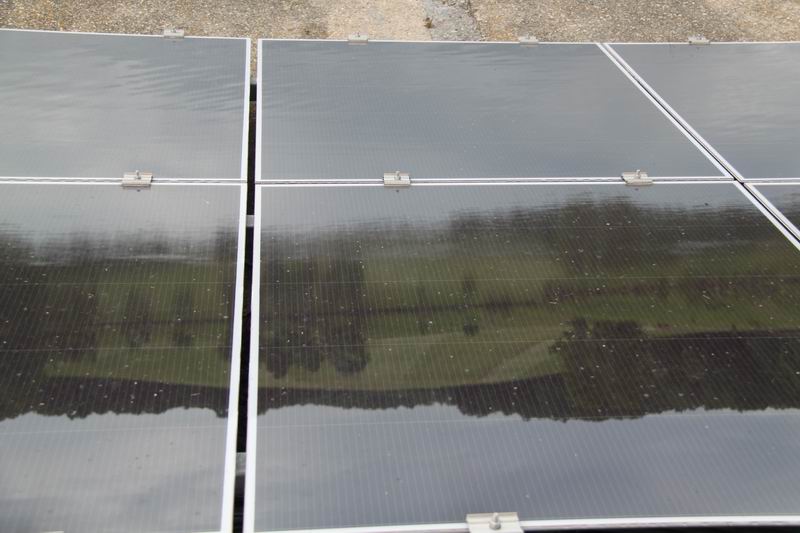
Every two segments of the panels, i.e. a total of 5 kW, are processed by one solar controller KOM DOMINATOR MPPT 200/100, the last digit 100 indicates the maximum current. When the voltage of the battery assembly is 48V, such controllers work at the limit, but good finning and additional coolers solved the heating problem.
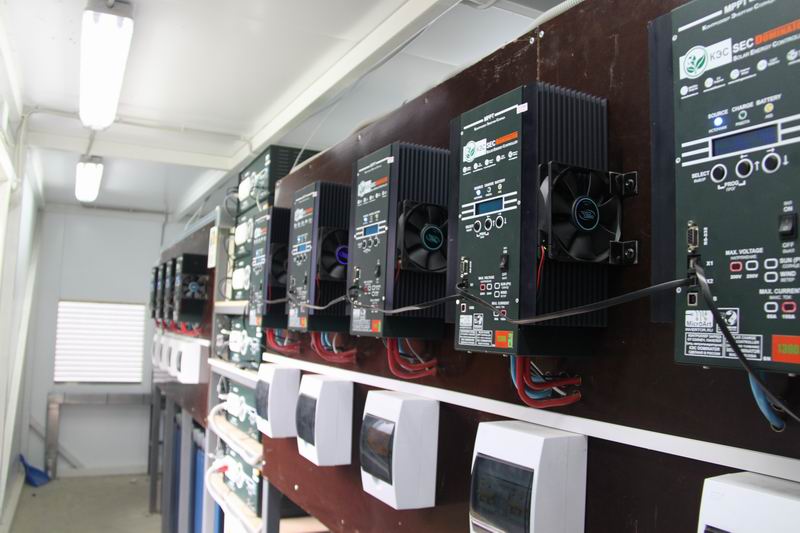
Next, the energy from the solar controllers is supplied to the battery assembly with a voltage of 48V. Armored batteries with a capacity of 960A * h each using 2B with hydrogen recovery plugs were used. The total capacity of the assembly is 5760 Ah, and if converted to energy, it is about 276 kWh, if you discharge the batteries completely. All batteries are connected to powerful current-carrying tires and this is clearly seen in the photo.
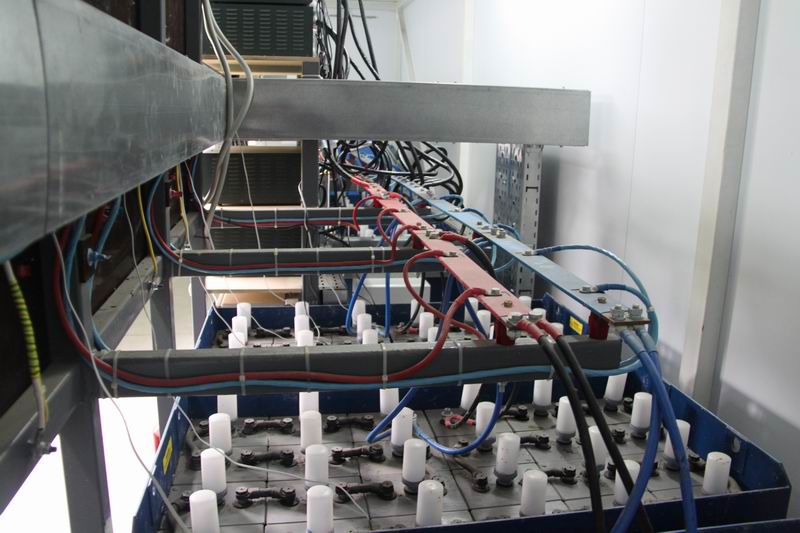
Inverters MAP DOMINATOR 48V 20kW are connected to the batteries. They are connected 6 pieces in a three-phase version, that is, each phase can remove power up to 40 kW. Since there are a lot of three-phase consumers on the farm, the condition was set to provide a three-phase network: here you can find pumps, power tools, and even household powerful electronics.
Inverters operate in the mode of pumping energy from the sun and are connected via the I2C bus to the solar controllers. As a result, the economy fully uses the energy of the sun, and gets the missing power from the network.
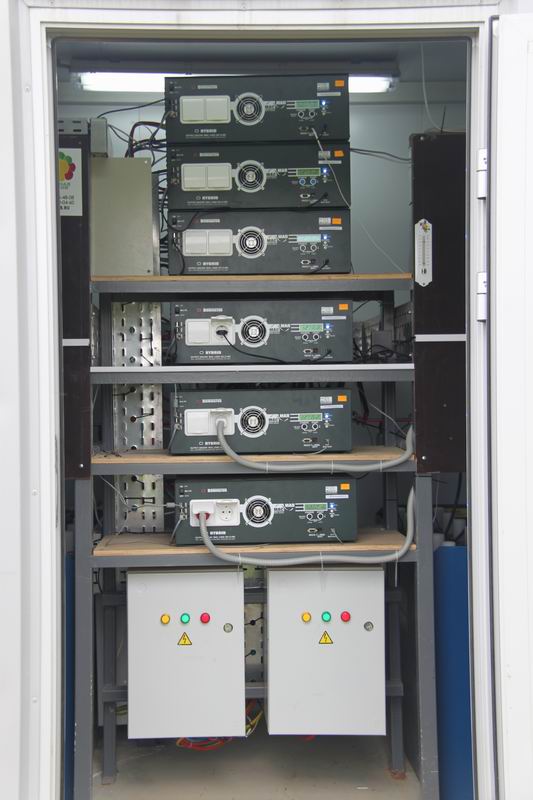
There is a separate switchboard in which all incoming and outgoing lines are switched. There is a 100KVA own substation, a 90 kW diesel generator with an autorun system and a switching system.

At the moment, the system works as follows:
Since there is a lot of sunshine in the Krasnodar Territory, the generator starts extremely rarely - there is enough power of solar panels and battery charge.
Since the system is quite powerful, there may be collisions, and monitoring the state of such a system would be superfluous. The MAP DOMINATOR inverters include the Malina software and hardware complex, which allows you to remotely monitor each of the inverters and even make changes to the settings. During the time I wrote this article, the Malina cloud service was launched, which allows all owners of such inverters to receive up-to-date information about their power system, even if the house does not have a white IP - the inverter itself connects to the server and sends data there.

The design team has applied some interesting solutions that do not immediately seem obvious, but which have allowed good savings. For example, the entire system is assembled in a small insulated trailer that heats up pretty well in the summer. What is surprising, but it turned out to be more profitable to organize the supply-and-exhaust ventilation, which works on the principle of aerotrub, rather than installing an air-conditioning system.
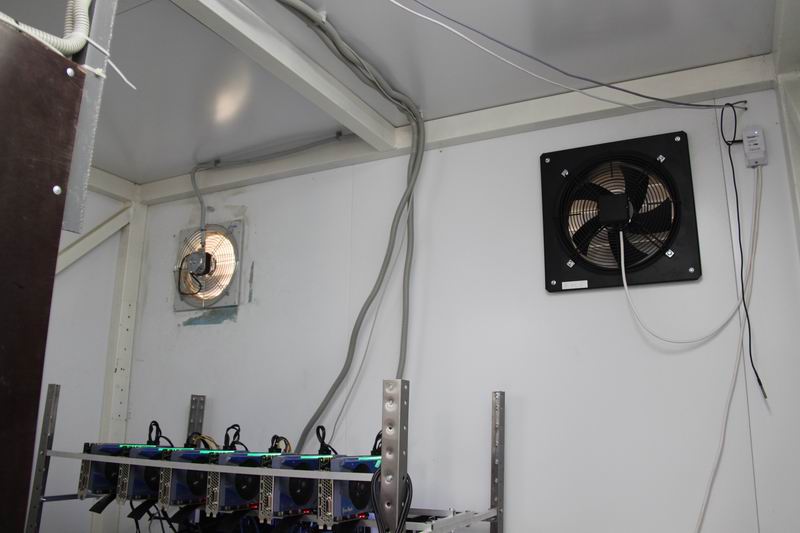
This solar hybrid power plant is designed with a good power reserve. At the moment, production from solar panels can be up to 300 kWh per day, and the manor consumes only 200 kWh per day. That is, there is a margin of a full third - this allows both adding consumers without making any changes, and for a rather long period of abandoning the external power grid - there is enough energy from the solar panels to compensate for the constant consumption and charge the batteries that have run down overnight . Unfortunately, the cost of energy from batteries is higher than the network one, since the number of their cycles is limited, therefore, it is still more profitable at night to be powered from an external power supply network (and the night tariff is more profitable than the day one). And it is pleasant that the majority of the components of this energy system are produced in Russia: it means that not all is lost, even if such systems are built on our components.
If the subject of solar power plants is interesting, then I can also tell you about less powerful “summer” solutions. Glad to any comments and see you soon!
To begin with, I will tell you a little about the history of the creation of this SES. Geographically, the facility is located in the Krasnodar Territory, where nature itself has the opportunity to use the energy of the sun. In addition, in the Krasnodar Territory there is a problem with the power supply in the summer months: because of the heat, everyone is beginning to actively use air conditioners and refrigeration units, thereby increasing the load on the electrical network. And the power plants themselves are also in harsh conditions: increased load, plus high temperatures, and this is where accidents and temporary outages occur.
So, the owner decided to protect his house and homestead from such power outages. The task was to provide autonomous power supply for a period of up to 3 hours. Practice has shown that the energy sector, as a rule, has had time to carry out all the work and restore the supply voltage.
')
Step 1. We reserve food
Thus, it was decided to install autonomous inverters with batteries. The calculation was made on the full reservation of the entire estate in full for a period of 3 hours. Since this period could be longer, it was decided to add a diesel generator to the autonomous inverters.

Step 2. Use the energy of the sun
It is logical that after installing autonomous inverters, the next step was the addition of solar panels. Thus, it was possible, without regard to the absence of an external network, to use electricity. Probably, the time has come for technical information.

Specifications
Solar modules: Micromorphic, Pramac (Switzerland) 125W x 360pcs.
Installed power of solar modules: 45kW
Solar controllers: IES DOMINATOR MPPT 200/100 200V 100A x 9pcs.
Inverters: MAP DOMINATOR 20kW x 6pcs (3-phase system of 2 MAP per phase)
Total inverter power: 120kW
Batteries: Crusade assembly 8PzS960 960Ach 48V with hydrogen recombination plugs x 6pcs
Total battery capacity: 5760Ah, 276kW * h
Diesel generator: JCB G115QS 90kW with automatic control.
How it works?
Micromorphic solar cells have one feature: their efficiency is slightly more than 9%, but at the same time they capture the infrared part of the spectrum, which means they are capable of producing more energy at sunrise, sunset and during cloudiness. In addition, each solar battery provides up to 100V voltage and has a capacity of 125 watts. Due to this, the fault tolerance problem was solved: all panels are connected in parallel and divided into 18 segments. Accordingly, in each segment turned out 20 panels, giving 2.5 kW of power. Since the panels are arranged in two rows, the results were decent along the length of the line. Here SIP wire came in handy, which has a sufficient cross section at an affordable price. and if one panel fails, the other 19 continue to work. And if the line is interrupted, only one of the 20 segments will fall out of work, so the losses will be insignificant.

Every two segments of the panels, i.e. a total of 5 kW, are processed by one solar controller KOM DOMINATOR MPPT 200/100, the last digit 100 indicates the maximum current. When the voltage of the battery assembly is 48V, such controllers work at the limit, but good finning and additional coolers solved the heating problem.

Next, the energy from the solar controllers is supplied to the battery assembly with a voltage of 48V. Armored batteries with a capacity of 960A * h each using 2B with hydrogen recovery plugs were used. The total capacity of the assembly is 5760 Ah, and if converted to energy, it is about 276 kWh, if you discharge the batteries completely. All batteries are connected to powerful current-carrying tires and this is clearly seen in the photo.

Inverters MAP DOMINATOR 48V 20kW are connected to the batteries. They are connected 6 pieces in a three-phase version, that is, each phase can remove power up to 40 kW. Since there are a lot of three-phase consumers on the farm, the condition was set to provide a three-phase network: here you can find pumps, power tools, and even household powerful electronics.
Inverters operate in the mode of pumping energy from the sun and are connected via the I2C bus to the solar controllers. As a result, the economy fully uses the energy of the sun, and gets the missing power from the network.

There is a separate switchboard in which all incoming and outgoing lines are switched. There is a 100KVA own substation, a 90 kW diesel generator with an autorun system and a switching system.

At the moment, the system works as follows:
- The maximum energy of the sun is used, and the missing power gets from the external network
- If the external network is turned off, invisibly to the hosts, the system goes offline. The energy of the sun is used and the disadvantage is compensated by the batteries.
- If an external power supply does not appear, there is no sun (night or overcast), and the battery charge approaches the specified limit, the diesel generator starts up automatically and transmits power to the entire farm, and the inverters charge the batteries at this time.
- As soon as the external network returns, the diesel generator shuts down and the system switches to standard operation.
Since there is a lot of sunshine in the Krasnodar Territory, the generator starts extremely rarely - there is enough power of solar panels and battery charge.
Remote control
Since the system is quite powerful, there may be collisions, and monitoring the state of such a system would be superfluous. The MAP DOMINATOR inverters include the Malina software and hardware complex, which allows you to remotely monitor each of the inverters and even make changes to the settings. During the time I wrote this article, the Malina cloud service was launched, which allows all owners of such inverters to receive up-to-date information about their power system, even if the house does not have a white IP - the inverter itself connects to the server and sends data there.

Features of operation
The design team has applied some interesting solutions that do not immediately seem obvious, but which have allowed good savings. For example, the entire system is assembled in a small insulated trailer that heats up pretty well in the summer. What is surprising, but it turned out to be more profitable to organize the supply-and-exhaust ventilation, which works on the principle of aerotrub, rather than installing an air-conditioning system.

Conclusion
This solar hybrid power plant is designed with a good power reserve. At the moment, production from solar panels can be up to 300 kWh per day, and the manor consumes only 200 kWh per day. That is, there is a margin of a full third - this allows both adding consumers without making any changes, and for a rather long period of abandoning the external power grid - there is enough energy from the solar panels to compensate for the constant consumption and charge the batteries that have run down overnight . Unfortunately, the cost of energy from batteries is higher than the network one, since the number of their cycles is limited, therefore, it is still more profitable at night to be powered from an external power supply network (and the night tariff is more profitable than the day one). And it is pleasant that the majority of the components of this energy system are produced in Russia: it means that not all is lost, even if such systems are built on our components.
If the subject of solar power plants is interesting, then I can also tell you about less powerful “summer” solutions. Glad to any comments and see you soon!
Source: https://habr.com/ru/post/418609/
All Articles